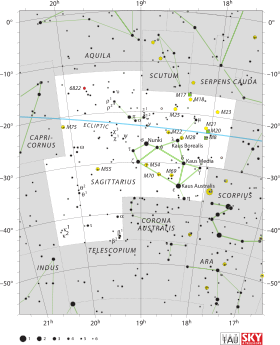Theta Sagittarii

|
| Observation data Epoch J2000.0 Equinox J2000.0 | |
|---|---|
| Constellation | Sagittarius |
| Right ascension | 19h 59m 51.3s |
| Declination | −34° 41' 52" |
| Apparent magnitude (V) | +5.30 |
| Distance | 157 ± 7 ly (48 ± 2 pc) |
| Spectral type | A4/A5IV |
| Other designations | |

|
| Observation data Epoch J2000.0 Equinox J2000.0 | |
|---|---|
| Constellation | Sagittarius |
| Right ascension | 19h 59m 44.2s |
| Declination | −35° 16' 35" |
| Apparent magnitude (V) | +4.37 |
| Distance | 618 ± 105 ly (189 ± 32 pc) |
| Spectral type | B2.5IV |
| Other designations | |
The Bayer designation Theta Sagittarii (Theta Sgr, θ Sagittarii, θ Sgr) is shared by two star systems, θ¹ Sagittarii and θ² Sagittarii, in the constellation Sagittarius. The two stars are separated by 0.58° in the sky.
θ¹ Sagittarii
Theta¹ Sagittarii (Theta¹ Sgr, θ¹ Sagittarii, θ¹ Sgr) is a spectroscopic binary lying 617 light years from Earth. The primary star, θ¹ Sagittarii A, is a spectral type B2.5 subgiant which has an apparent magnitude of +4.37. The companion star, θ¹ Sagittarii B, is approximately 0.2 arcseconds from the primary, which puts them 31 astronomical units (AU) apart (a Sun-Neptune distance).
Theta¹ Sagittarii is moving through the Galaxy at a speed of 19.9 km/s relative to the Sun. Its projected Galactic orbit carries it between 20,900 and 24,300 light years from the center of the Galaxy.[1]
θ² Sagittarii
Theta² Sagittarii (Theta² Sgr, θ² Sagittarii, θ² Sgr) is a triple star system 157 light years from Earth. θ² Sagittarii A is a spectral type A4/5 subgiant which has an apparent magnitude of +5.30. Orbiting the primary with a separation on the sky of 30 arcseconds, or at least 1400 AU, is binary star composed of θ² Sagittarii B, a magnitude +10.8 star, and θ² Sagittarii C, with a magnitude of +11.5. B and C are 1.2 arcseconds, or approximately 58 AU apart.
Theta² Sagittarii is moving through the Galaxy at a speed of 34.6 km/s relative to the Sun. Its projected Galactic orbit carries it between 22,800 and 26,100 light years from the center of the Galaxy.[2]